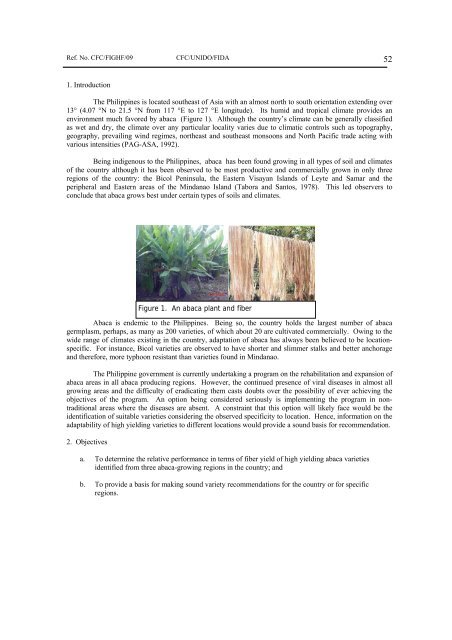ABACA Activities in the Philippines - Unido
ABACA Activities in the Philippines - Unido
ABACA Activities in the Philippines - Unido
Create successful ePaper yourself
Turn your PDF publications into a flip-book with our unique Google optimized e-Paper software.
Ref. No. CFC/FIGHF/09 CFC/UNIDO/FIDA 52<br />
1. Introduction<br />
The Philipp<strong>in</strong>es is located sou<strong>the</strong>ast of Asia with an almost north to south orientation extend<strong>in</strong>g over<br />
13° (4.07 °N to 21.5 °N from 117 °E to 127 °E longitude). Its humid and tropical climate provides an<br />
environment much favored by abaca (Figure 1). Although <strong>the</strong> country’s climate can be generally classified<br />
as wet and dry, <strong>the</strong> climate over any particular locality varies due to climatic controls such as topography,<br />
geography, prevail<strong>in</strong>g w<strong>in</strong>d regimes, nor<strong>the</strong>ast and sou<strong>the</strong>ast monsoons and North Pacific trade act<strong>in</strong>g with<br />
various <strong>in</strong>tensities (PAG-ASA, 1992).<br />
Be<strong>in</strong>g <strong>in</strong>digenous to <strong>the</strong> Philipp<strong>in</strong>es, abaca has been found grow<strong>in</strong>g <strong>in</strong> all types of soil and climates<br />
of <strong>the</strong> country although it has been observed to be most productive and commercially grown <strong>in</strong> only three<br />
regions of <strong>the</strong> country: <strong>the</strong> Bicol Pen<strong>in</strong>sula, <strong>the</strong> Eastern Visayan Islands of Leyte and Samar and <strong>the</strong><br />
peripheral and Eastern areas of <strong>the</strong> M<strong>in</strong>danao Island (Tabora and Santos, 1978). This led observers to<br />
conclude that abaca grows best under certa<strong>in</strong> types of soils and climates.<br />
Abaca is endemic to <strong>the</strong> Philipp<strong>in</strong>es. Be<strong>in</strong>g so, <strong>the</strong> country holds <strong>the</strong> largest number of abaca<br />
germplasm, perhaps, as many as 200 varieties, of which about 20 are cultivated commercially. Ow<strong>in</strong>g to <strong>the</strong><br />
wide range of climates exist<strong>in</strong>g <strong>in</strong> <strong>the</strong> country, adaptation of abaca has always been believed to be locationspecific.<br />
For <strong>in</strong>stance, Bicol varieties are observed to have shorter and slimmer stalks and better anchorage<br />
and <strong>the</strong>refore, more typhoon resistant than varieties found <strong>in</strong> M<strong>in</strong>danao.<br />
The Philipp<strong>in</strong>e government is currently undertak<strong>in</strong>g a program on <strong>the</strong> rehabilitation and expansion of<br />
abaca areas <strong>in</strong> all abaca produc<strong>in</strong>g regions. However, <strong>the</strong> cont<strong>in</strong>ued presence of viral diseases <strong>in</strong> almost all<br />
grow<strong>in</strong>g areas and <strong>the</strong> difficulty of eradicat<strong>in</strong>g <strong>the</strong>m casts doubts over <strong>the</strong> possibility of ever achiev<strong>in</strong>g <strong>the</strong><br />
objectives of <strong>the</strong> program. An option be<strong>in</strong>g considered seriously is implement<strong>in</strong>g <strong>the</strong> program <strong>in</strong> nontraditional<br />
areas where <strong>the</strong> diseases are absent. A constra<strong>in</strong>t that this option will likely face would be <strong>the</strong><br />
identification of suitable varieties consider<strong>in</strong>g <strong>the</strong> observed specificity to location. Hence, <strong>in</strong>formation on <strong>the</strong><br />
adaptability of high yield<strong>in</strong>g varieties to different locations would provide a sound basis for recommendation.<br />
2. Objectives<br />
Figure 1. An abaca plant and fiber<br />
a. To determ<strong>in</strong>e <strong>the</strong> relative performance <strong>in</strong> terms of fiber yield of high yield<strong>in</strong>g abaca varieties<br />
identified from three abaca-grow<strong>in</strong>g regions <strong>in</strong> <strong>the</strong> country; and<br />
b. To provide a basis for mak<strong>in</strong>g sound variety recommendations for <strong>the</strong> country or for specific<br />
regions.

















